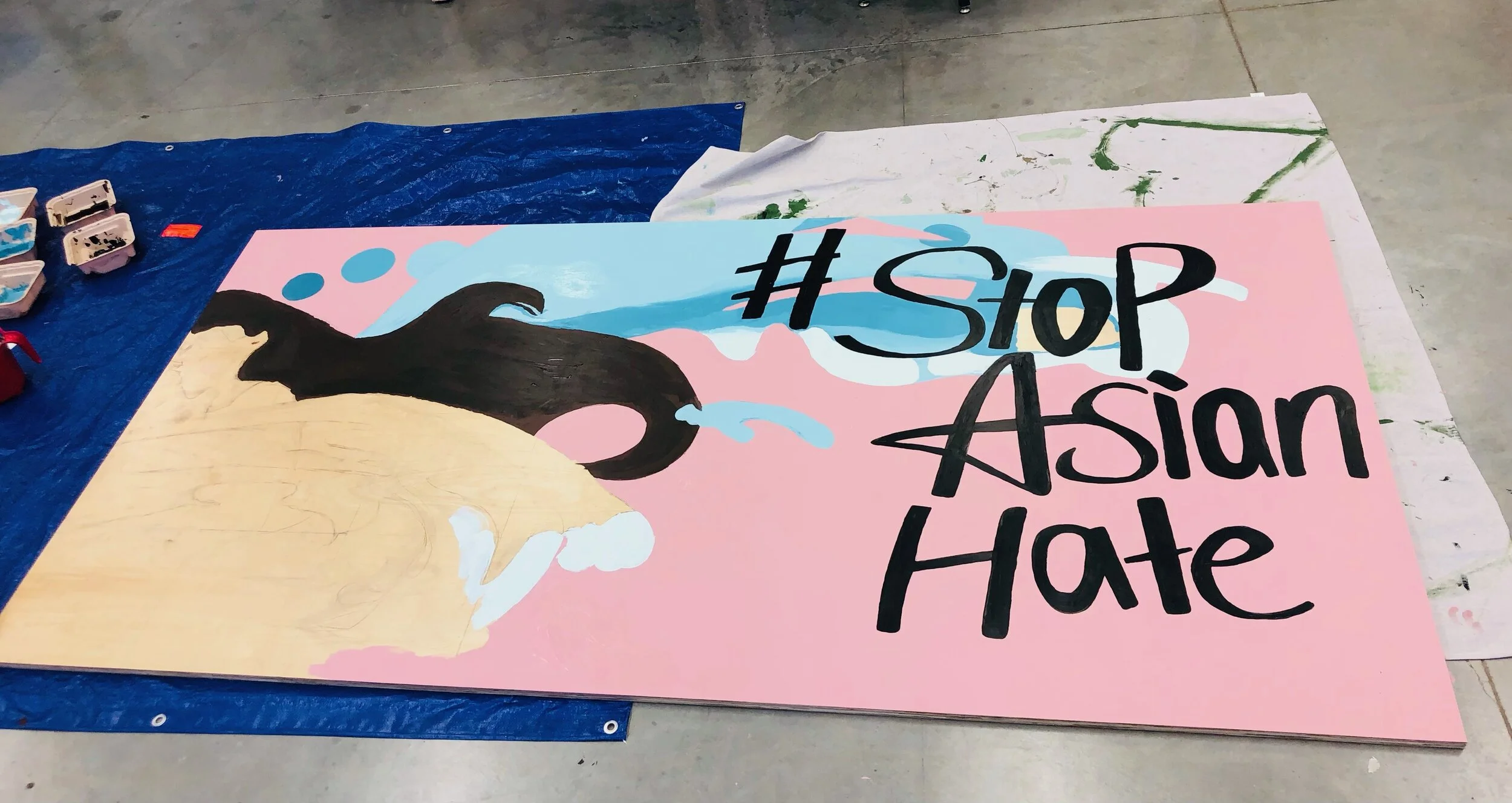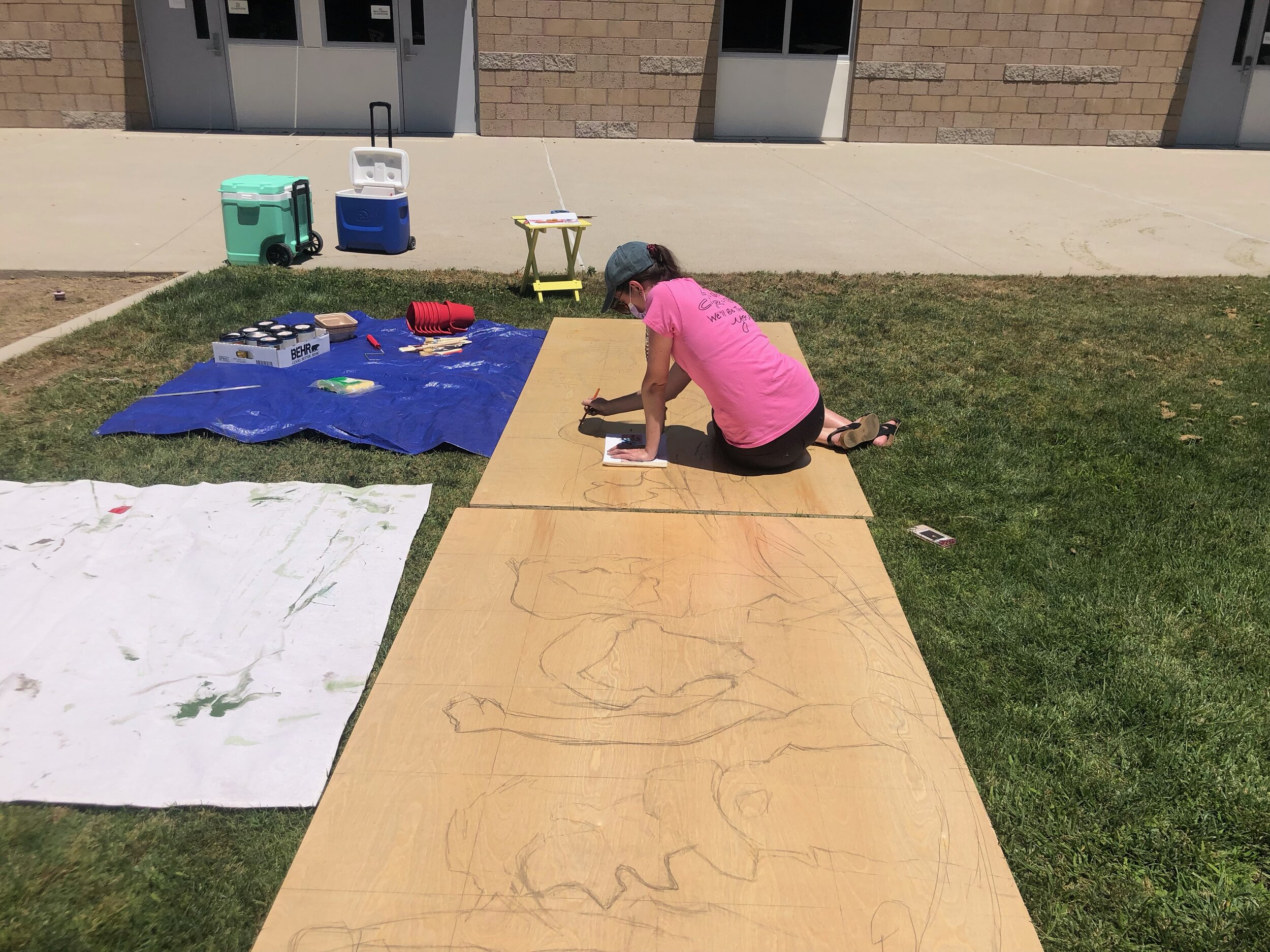As Hate Crimes Against Asians Surge, a Student Speaks Out Through Art
Haruka Noda organized Irvine, California’s first youth-led city mural to address the anti-Asian sentiments.
By Claudia Lin
Vibrant colors spill out of paint buckets as Haruka Noda, a high school student in Irvine, California, lowers her paintbrush, tinted with turquoise, and begins making delicate strokes onto one square of wood. It’s only a fraction of what will become the first city mural to be painted in Irvine by high school students.
Sixty squares. Sixteen feet wide. Four feet long.
But this mural is not just a simple piece of art for audiences to stare at and walk by. Its deeper meaning lies within the three words plastered on its front: “Stop Asian Hate.”
An art contest was held for the design where people would submit thumbnails or tiny sketches of a mural design. Out of all the designs, Haruka Noda and Moir selected high school student Zillin Jin’s design because of its horizontal composition and bold color choices. Photo by Yoko Noda
As COVID-19 spread across the nation in March 2020, a rise in rhetoric blaming Asian people for its origin in China also followed. The number of reported anti-Asian hate crime events increased by 107% in 2020, from 43 in 2019 to 89 in 2020 where the highest number of anti-Asian reported hate crime events occurred in March and April 2020, according to the California Department of Justice.
For Noda, a Japanese American living in Irvine, the rise in hate crimes was deeply troubling. When she saw online that an elderly Asian man had been attacked in Woodbridge, California, she sought out ways to use her passion for art — particularly murals — in ways that would help call public attention to the issue.
After weeks of conversations with art teachers and city government officials, Noda established Paint for No Hate, an initiative consisting of high school students from the Irvine Unified School District who would aim to create the city’s first youth-led mural project.
“Paint for No Hate is about bringing high school students together to paint in response to Asian hate crimes,” Noda says. “And really, my goal was to create a message for the city because there wasn’t a lot of public art in Irvine because of strict regulations.”
But the initiative to use public art to push for social justice didn’t stem just from the events that flooded the media at the time, Noda says. It was also her passion for art history that drove her to create this project.
Noda has taken art classes since elementary school, but it wasn’t until she took an honors class that she discovered this intersection between art and activism through exploring art through the centuries, including the Renaissance and the impressionist era.
“In modern and contemporary art history, you see a lot of activism and art being connected,” Noda says. “I think the best example that I could think of was the Berlin Wall, like people who painted murals on the wall. And I thought that was a really strong message.”
Noda emailed her art teacher, Kearci Moir, who was intrigued by the idea. But as Noda and Moir learned, there was more to it than picking up a paint brush.
“Interacting with all the bureaucracy in the student government was really interesting and eye-opening for me to see how much red tape there can be for public art,” Moir says.
After their initial discussion, Noda and Moir began contacting city officials, from council member Anthony Kuo to team representative Ryan Painter for Youth Action Team, a youth leadership organization.
As these conversations progressed, Noda encountered a challenge with coordinating her project with other people because of differences in opinions and visions for the mural. One group offered to finance the project but wanted the mural to focus more on the need for kindness rather than on hate crimes.
Art teacher Kearci Moir sketched the mural design on a wooden plane. Moir was also responsible for the inclusion of the Black Lives Matter sign on the final design. Photo by Yoko Noda
It wasn’t until Noda reached out to Vice Mayor Tammy Kim that she was able to execute her project the way she envisioned it. In the end, the mural also included a message about Black Lives Matter, in a show of solidarity.
High school students from all over Irvine gathered to paint the mural. One student, Dheeksha Bhima Reddy, was moved by the idea.
“I felt pride, to be honest, that I was representing my community and representing my heritage.” Bhima Reddy says. “For once, I felt like I was doing something for myself and for my family, and it felt really good.”
After two days of painting, the mural was finally ready to be showcased in the Irvine Summer Art Market at the Palm Courts in the Great Park. Reflecting back on this journey, Noda recalls one of her favorite memories.
“The first memory that I guess I remember the most was going to Home Depot with Ms. Moir and just like picking out paint colors and picking out paint brushes,” she says, adding, “That was the moment I realized, ‘Oh, this is really happening. And I get to actually make this a tangible thing now, instead of just an idea.’ ”
High school students Isabelle Huang, Zillin Jin and art teacher Kearci Moir gathered in the art studio at Portola High School to paint the mural. Each student was assigned a square to paint. Photo by Yoko Noda
While the mural was not set to be permanently displayed due to restrictive city guidelines on public art, it reached a wide audience and garnered attention for the issue. Noda recalls a moment when an elderly Asian woman approached her and talked about the troubling issues she saw with society and also that, despite the mural’s beauty, she was sad that it had to be made in the first place.
While Noda hopes to pursue a new public art project in the future, she says she wants to focus more on educating others on how to put up their own public art.
Now, Noda aims to host community sessions to help art students create murals and teach them how to overcome the challenges she had to face along her own journey.




